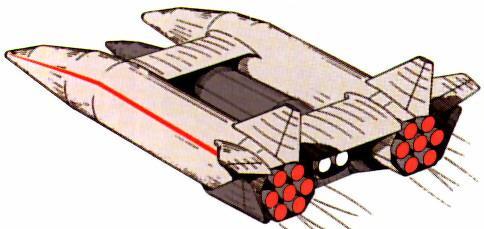
Home - Search - Browse - Alphabetic Index: 0- 1- 2- 3- 4- 5- 6- 7- 8- 9
A- B- C- D- E- F- G- H- I- J- K- L- M- N- O- P- Q- R- S- T- U- V- W- X- Y- Z
Shuttle HCR

MM Shuttle Phase B
Martin Marietta Shuttle Phase B
Credit: Martin Marietta
Status: Study 1969. Thrust: 25,839.70 kN (5,808,996 lbf). Gross mass: 1,977,415 kg (4,359,453 lb). Height: 85.00 m (278.00 ft). Diameter: 10.00 m (32.00 ft).
The McDonnell Douglas/Martin Marietta Phase B shuttle proposal was designed under Contract NAS9-100959. The team proposed that the originally requested 6,800 kg payload would be achieved in the prototype, with the revised 11,500 kg payload to be obtained by making changes to lighten the orbiter as a result of development findings.
The high cross range orbiter had a 92,300 pound empty mass and the same engine configuration as the low cross range orbiter (2 x 188,000 kgf engines and 4 x 8,200 kgf turbofan air-breathing engines). But the aerodynamics gave it a 2784 km cross range and a 300 kph landing speed. It also had a titanium structure enclosing aluminum propellant tanks, but the thermal protection system was made of a metallic cobalt super alloy, with columbium leading edge panels.
The booster for both versions was the low cross range configuration design used by the same contractors in Phase A. This had a high wing to the rear, and canards forward. The empty weight of the low cross range version was 205,353 kg. The10-m body diameter was intended to allow use of existing Saturn V tooling to fabricate the propellant tanks. The high cross range booster was slightly larger and heavier to accommodate the heavier high cross-range orbiter.
A number of expendable upper stages were considered that could replace the manned orbiter for cargo missions. These included:
- Saturn IVB with 4 x Minuteman solid motors as a third stage: 54,400 kg to orbit; $ 82 million development cost, $ 23.7 million per flight cost, for a cost per kilogram to orbit of $ 436
- Saturn II equipped with two shuttle engines, and a nuclear hybrid third stage: 59,000 kg to orbit; $ 106 million development cost, $ 22.2 million per flight cost, for a cost per pound to orbit of $ 409. Alternative, an S-II stage with two shuttle engines and 4 solid rocket motors as a third stage could put 63,500 kg into orbit.
- New design second stage with 2 shuttle engines: 77,000 kg payload; $ 320 million development cost, $ 27.6 million per flight cost, for a cost per pound to orbit of $ 359
The team also examined the costs to establish launch facilities. A Kennedy Space Center shuttle launch facility, taking advantage of existing Saturn V and Apollo infrastructure, would cost $ 87 million and take five years to build. One at Vandenberg AFB would cost $ 285 million, and one at White Sands would cost $ 317 million and take seven years to build.
Stage Data - Shuttle HCR
- Stage 1. 1 x Shuttle HCR-1. Gross Mass: 1,634,467 kg (3,603,382 lb). Empty Mass: 304,535 kg (671,384 lb). Thrust (vac): 29,135.625 kN (6,549,949 lbf). Isp: 442 sec. Burn time: 195 sec. Isp(sl): 392 sec. Diameter: 10.00 m (32.00 ft). Span: 46.04 m (151.04 ft). Length: 70.79 m (232.25 ft). Propellants: Lox/LH2. No Engines: 14. Engine: SSME Study. Status: Study 1969 December. Comments: Swept wing configuration.
- Stage 2. 1 x Shuttle HCR-2. Gross Mass: 342,948 kg (756,070 lb). Empty Mass: 129,329 kg (285,121 lb). Thrust (vac): 4,719.636 kN (1,061,016 lbf). Isp: 459 sec. Burn time: 201 sec. Isp(sl): 359 sec. Diameter: 7.50 m (24.60 ft). Span: 29.73 m (97.53 ft). Length: 48.26 m (158.33 ft). Propellants: Lox/LH2. No Engines: 2. Engine: SSME Study. Status: Study 1969 December. Comments: Delta winged configuration.
Family: orbital launch vehicle, Winged. Country: USA. Engines: SSME Study. Stages: Shuttle HCR-1, Shuttle HCR-2. Agency: Martin, Douglas.
Back to top of page
Home - Search - Browse - Alphabetic Index: 0- 1- 2- 3- 4- 5- 6- 7- 8- 9
A- B- C- D- E- F- G- H- I- J- K- L- M- N- O- P- Q- R- S- T- U- V- W- X- Y- Z
© 1997-2019 Mark Wade - Contact
© / Conditions for Use